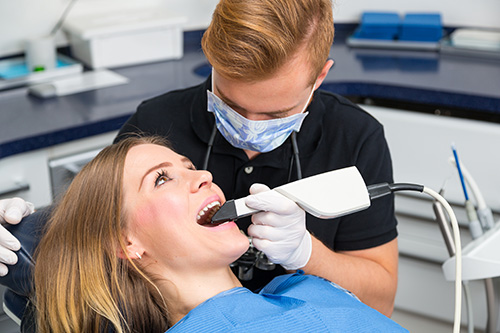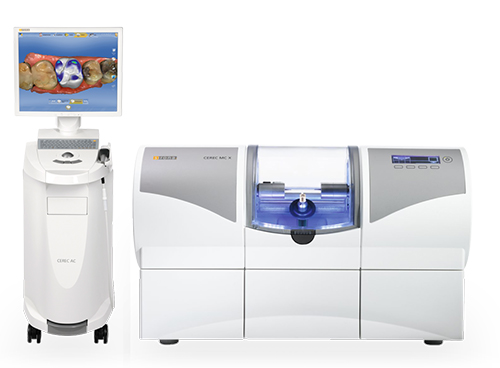Enjoy the Benefits of a Beautiful Smile in Just a Single Visit!
CEREC® offers convenient, faster and more comfortable care to provide a range of high quality same day restorations including ceramic crowns, inlays and onlays.

CEREC® offers convenient, faster and more comfortable care to provide a range of high quality same day restorations including ceramic crowns, inlays and onlays.

In just one appointment you can have a naturally beautiful restoration to enhance the beauty and function of your smile. With CEREC® there is no need for multiple office visits, messy dental impressions, a temporary crown, or waiting weeks for your dental work to come back from the laboratory. Your new restoration is designed and customized to the exact specifications of your smile all in the very same day!

CEREC® is an advanced method of dental care, which allows for the preparation and placement of same day ceramic restorations. Offering the utmost in terms of quality and convenience, this high-tech system utilizes CAD/CAM technology, or computer aided design and computer aided manufacturing to make every step of the restoration process more patient-friendly and precise. Using an ergonomically designed intraoral scanning wand in place of a conventional dental impression, the dentist is able to capture detailed 3D images of the prepared tooth and surrounding dentition. These images are then integrated by an advanced computer software program to produce an accurate model and plan a precise fitting, functional, and cosmetically pleasing restoration. As soon the restoration is designed and approved by the dentist, the information is sent wirelessly to a chairside milling machine where a ceramic restoration is fabricated as the patient waits.

A CEREC® single visit crown offers much more than a convenient approach to getting a dental crown. It is a high quality, naturally beautiful, extremely durable and long-lasting dental restoration!
CEREC is a dental system that uses CAD/CAM technology to design and fabricate ceramic restorations chairside in a single visit. Instead of sending physical impressions to an offsite dental laboratory, the restoration is designed digitally and milled on-site for immediate placement. This approach streamlines treatment while maintaining precision through computer-aided design and manufacturing.
Compared with traditional restorations, CEREC eliminates the need for temporary crowns and multiple appointments, reducing disruption to a patient’s schedule. The digital workflow can improve fit and consistency by using objective design data rather than manual laboratory processes. Many modern dental practices adopt CEREC to deliver advanced, patient-friendly restorative care.
CEREC is commonly used to create single crowns, inlays, onlays and veneers fabricated from high-strength ceramic materials. The system can address both posterior function and anterior esthetics when the clinical situation supports a chairside ceramic solution. Because restorations are milled from monolithic ceramic blocks, they combine structural integrity with an attractive appearance.
CEREC can be appropriate for functional repairs and cosmetic improvements depending on individual needs and tooth structure. Your dentist will evaluate decay extent, existing restorations and occlusal forces to determine whether a CEREC restoration is the best choice. In some complex cases, laboratory-fabricated alternatives may still be recommended for optimal results.
A typical CEREC appointment begins with tooth preparation followed by a digital impression captured with an intraoral scanner. The scan creates a detailed 3D model that the dentist refines using CAD software to design the restoration’s shape, contacts and occlusion. Once the design is approved, the data is sent to a chairside milling unit that carves the restoration from a ceramic block.
After milling, the restoration is tried in, adjusted and finished with glazing or polishing to match texture and shine. The dentist bonds the restoration to the prepared tooth using established adhesive techniques for a reliable seal and fit. The entire process is completed during a single visit, allowing patients to leave with a final restoration in place.
CEREC restorations are fabricated from high-strength ceramic materials that resist wear and provide excellent fracture resistance when properly indicated and bonded. Longevity depends on clinical factors such as oral hygiene, bite forces, bruxism and the quality of the remaining tooth structure. When placed and cared for correctly, CEREC restorations can provide many years of reliable service.
Regular dental checkups and preventative maintenance play an important role in extending the life of any restoration by identifying issues early and addressing marginal wear or recurrent decay. If a restoration shows signs of damage, the dentist can evaluate repair or replacement options to restore function. The practice follows strict protocols to ensure durable fit and function for every restoration we place.
The digital impression process uses an ergonomically designed intraoral scanning wand to capture high-resolution images of the teeth and surrounding tissues. Most patients find scans more comfortable than traditional putty impressions because there is no bulky tray or long setting time. The scanner provides immediate visual feedback so the dentist can verify capture and rescan any missed areas.
Digital data also improves clinical communication and reduces the chance of errors related to distorted impressions or cast pouring. Scans are readily archived and shared with the milling system or with specialists when collaboration is needed. Your dentist will explain the scanning steps and answer any questions to ensure a smooth experience.
CEREC restorations can be customized in color, translucency and shape to blend with adjacent teeth through selection of appropriate ceramic blocks and chairside characterization. The dentist evaluates shade, morphology and surface texture during the design phase to reproduce natural contours and contacts for a lifelike appearance. Final glazing and polishing refine the restoration’s surface to match surrounding dentition.
While CEREC achieves excellent esthetic results for many indications, complex cosmetic cases may require additional characterization or laboratory support to meet very specific demands. The dentist will discuss expected outcomes and any steps needed to optimize color match and anatomical detail. Patient input and photographic records help guide final adjustments for a harmonious result.
Good candidates for CEREC restorations are patients who require single-tooth crowns, inlays or onlays and who have sufficient healthy tooth structure to support a bonded ceramic restoration. Patients with active periodontal disease or extensive structural damage may need preliminary care before restorative treatment proceeds. Individuals with severe bruxism or uncontrolled bite issues should be evaluated to determine whether special design features or protective appliances are necessary.
The dentist performs a comprehensive exam, including radiographs and occlusal analysis, to confirm that a CEREC restoration is clinically appropriate. If CEREC is not the ideal option, the practice will explain alternative restorative paths and the reasons they may be preferable. The goal is to select the safest, most predictable treatment for long-term oral health.
Same-day CEREC restorations reduce the number of appointments and eliminate the need for temporary crowns, which can decrease the risk of interim discomfort or restoration failure. The digital workflow shortens turnaround time while preserving clinician control over design, fit and occlusion. Patients often appreciate the convenience and the ability to complete restorative treatment in a single visit.
Chairside fabrication also allows the dentist to make immediate adjustments and confirm esthetics and function before final bonding. Keeping the process under the clinician’s direct supervision from start to finish supports predictable outcomes. These features enable efficient, patient-centered care without compromising clinical standards.
After receiving a CEREC restoration, basic oral hygiene practices such as brushing twice daily with a fluoride toothpaste and daily flossing remain essential to protect surrounding teeth and margins. Avoiding excessively hard or sticky foods for a short period after placement helps the bond mature and minimizes early stress on the restoration. If you grind your teeth, the dentist may recommend a protective nightguard to reduce long-term wear.
Regular dental checkups and professional cleanings allow the dentist to monitor restoration margins and detect early signs of wear, recurrent decay or fracture. If you experience sensitivity, loosening or changes in bite, contact the office promptly so the dentist can be evaluated. Proper maintenance helps maximize the lifespan and performance of any ceramic restoration.
At Bahri Dental Group, we integrate CEREC with our established infection control, sterilization and quality protocols to deliver safe, predictable restorative care. Clinicians receive training on CAD/CAM workflows and material science to ensure each digital design and mill is optimized for fit and strength. Our office follows manufacturer recommendations and validated bonding protocols to achieve durable, well-seated restorations.
We emphasize clear patient communication, careful preoperative planning and thorough follow-up to confirm function and comfort after placement. Digital records from the CEREC system support long-term monitoring and efficient recall if future adjustments are needed. Patients can expect the same high standards of safety and compassionate care that define our practice.
Our goal is to help every patient experience the benefits of good oral health and a beautiful smile. We value the trust you have placed in our office and strive to provide solutions that meet your dental and orthodontic needs and expectations of care.

Phone